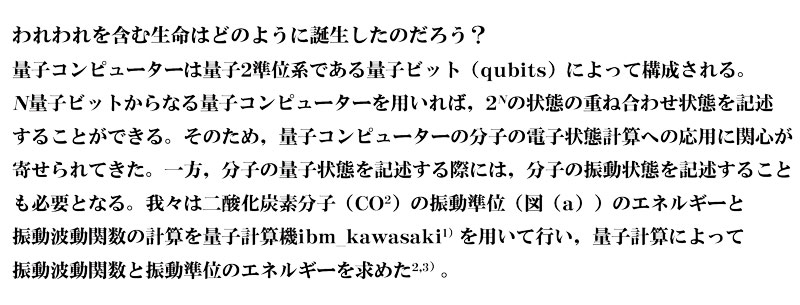Disclaimer: machine translated by DeepL which may contain errors.
ComputingtheVibrational Energy of CO2 Using a Quantum Computer
Lötstedt Erik, Associate Professor, Department of Chemistry
Kaoru Yamauchi, Professor, Department of Chemistry

![]()
We employed the variational quantum eigensolver (VQE) method4) to calculate the vibrational level energy of the triatomic molecule CO2, which is also known as a greenhouse gas. VQE describes a wave function that depends on the variational parameters on a quantum computer, and then optimizes the variational parameters by an optimization algorithm using a classical computer to obtain an approximate value of the energy so that the energy is minimized. In other words, the optimal energy was obtained by a hybrid method using both a quantum computer and a classical computer.
Figure (b,c) shows the energy of the lower energy level of the Fermi doublet of CO2 obtained by the quantum calculation. This was obtained by a method called reduced multistate contracted variational quantum eigensolver (RMC-VQE),3 which is an improvement of the VQE method. In this RMC-VQE, only the necessary matrix elements are obtained by a quantum computer, and the other matrix elements are obtained by a classical computer. The reason for this approach is to reduce the effect of errors in the results of quantum computation due to various types of noise when using the quantum computers available at present. The error must then be properly corrected for the values of the matrix elements evaluated using the quantum computer.
The histograms shown in Figure (b,c) are the results obtained by computing the Hamiltonian matrix 100 times and diagonalizing it each time. In computing the matrix elements, each quantum circuit was run 8192 times and the average value was obtained. As shown in this figure, the average value of the level energy obtained by the RMC-VQE method, even before error correction, shows a small gap of about 0.2 cm-1 from the error-free value obtained by the classical computer, and after error correction, the gap is even smaller, about 0.05 cm-1. This indicates that the energy of the vibrational level of the CO2 molecule can be obtained with high accuracy by a quantum computer if the RMC-VQE method is used and error correction is properly performed.
This study shows that quantum computation will be a useful method not only for the calculation of the electronic state5) but also for the calculation of the vibrational state of molecules in the future. It is expected that quantum computers will be used in the future to calculate the vibrational levels of larger size polyatomic molecules.
This work was published in Erik Lötstedt et al., AVS Quantum Science 4, 036801 (2022).
* 1) IBM Quantum team, https://quantum-computing.ibm.com, 2021, ibm_kawasaki v1.3.20, 2) E. Lötstedt, K. Yamanouchi, T. Tsuchiya, and Y. Tachikawa, Phys. Rev. A103, 062609 (2021), 3) E. Lötstedt, K. Yamanouchi, and Y. Tachikawa, AVS Quantum Science 4, 036801 (2022), 4) A. Peruzzo et al. Peruzzo et al., Nat. Commun. 5, 4213 (2014), 5) R. Yoshida, E. Lötstedt, and K. Yamanouchi, J. Chem. Phys. 156, 184117 (2022).
(Press release, July 14, 2022)
Published in Faculty of Science News, November 2022
Communicating to Faculty Research Students at the Forefront of Research>



